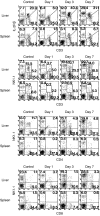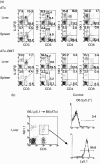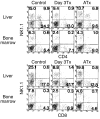Size of the population of CD4+ natural killer T cells in the liver is maintained without supply by the thymus during adult life
- PMID: 11683952
- PMCID: PMC1783301
- DOI: 10.1046/j.1365-2567.2001.01289.x
Size of the population of CD4+ natural killer T cells in the liver is maintained without supply by the thymus during adult life
Abstract
Given that there are few natural killer T (NKT) cells in the liver of athymic nude mice and in neonatally thymectomized mice, it is still controversial whether all NKT cells existing in the liver are supplied by the thymus or if some such cells develop in the liver. To determine whether or not NKT cells are consistently supplied from the thymus during adult life, thymectomy was conducted in mice at the age of 8 weeks. Interestingly, the proportion and number of CD4+ NKT cells increased or remained unchanged in the liver after adult thymectomy and this phenomenon continued for up to 6 months after thymectomy. The administration of alpha-galactosylceramide induced severe cytopenia (due to apoptosis) of CD4+ NKT cells in the liver on day 1, but subsequent expansion of these NKT cells occurred in thymectomized mice similar to the case in normal mice. However, in thymectomized mice given lethal irradiation (9.5 Gy) and subsequent bone marrow transfer, the population of CD4+ NKT cells no longer expanded in the liver, although that of CD8+ NKT cells did. These results suggest that thymic CD4+ NKT cells, or their progenitors, may migrate to the liver at a neonatal stage but are not supplied from the thymus in the adult stage under usual conditions. CD8+ NKT cells can be generated in the liver.
Figures





References
-
- Bendelac A. Mouse NK1+ T cells. Curr Opin Immunol. 1995;7:367–74. - PubMed
-
- Bix M, Locksley RM. Natural T cells: Cells that co-express NKRP-1 and TCR. J Immunol. 1995;155:1020–2. - PubMed
-
- Vicari AP, Zlotnik A. Mouse NK1.1+ T cells: a new family of T cells. Immunol Today. 1996;17:71–6. - PubMed
-
- Abo T, Kawamura T, Watanabe H. Physiological responses of extrathymic T cells in the liver. Immunol Rev. 2000;174:135–49. - PubMed
Publication types
MeSH terms
Substances
LinkOut - more resources
Full Text Sources
Research Materials

